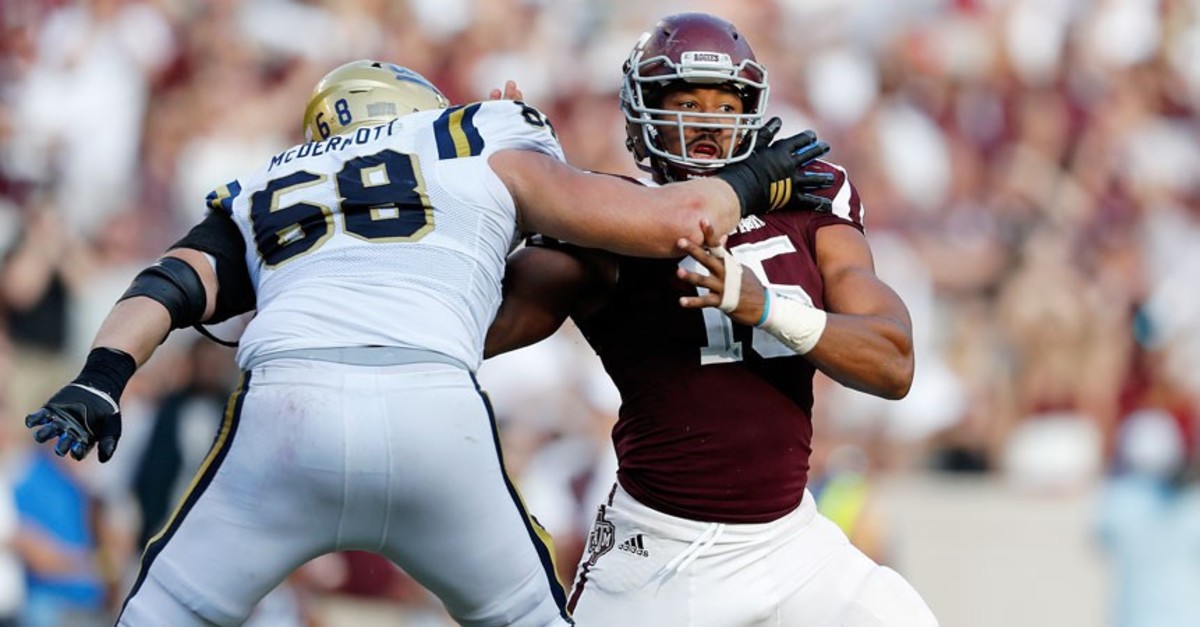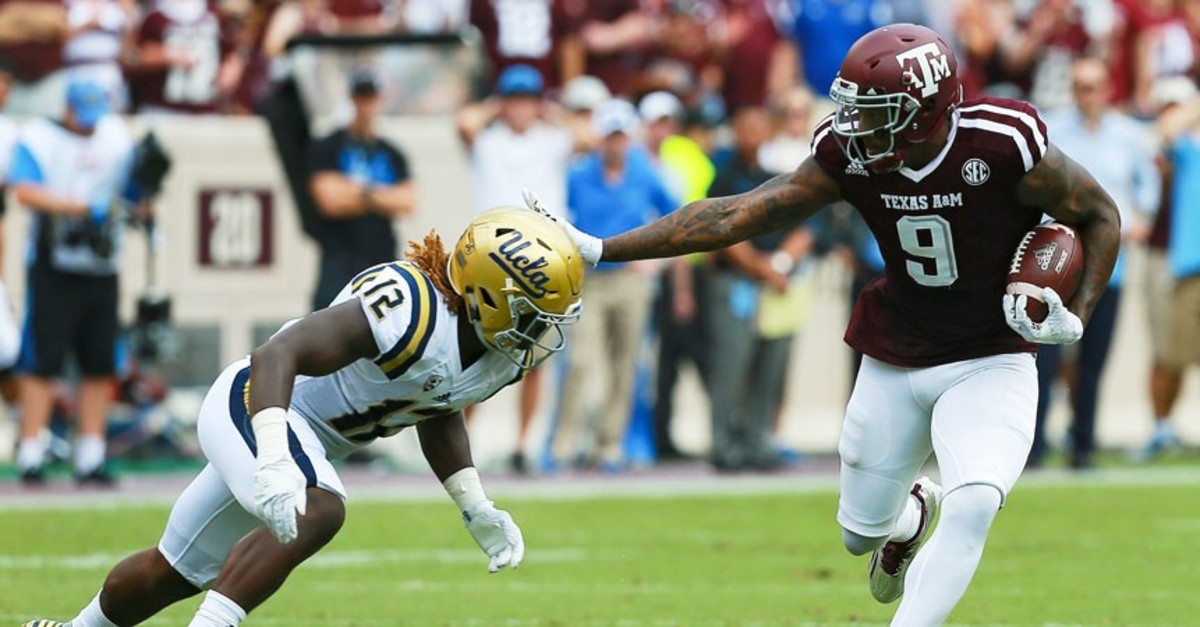Serenity Now: Kevin Sumlin has Texas A&M off on the right foot, but can he maintain enough stability to secure his job?

COLLEGE STATION, Texas—It is a broiling Monday in September, and Kevin Sumlin occupies the ideal spot, away from the heat for now: In an air-conditioned office, Texas A&M's head coach sits alone at a desk covered in papers and binders, scrutinizing his computer screen and not pressed to test the voice that nearly expired after a season-opening win over UCLA. In these parts, good climate control should not be taken lightly at the moment. Nor should anyone underrate a bit of peace and quiet.
A few feet away from the Aggies coach, four flat screens flicker with game replays and highlight shows.
"Key is, there's no sound on any of those," Sumlin says. "Notice that?"
A long, loud laugh follows. But otherwise all's quiet at Texas A&M, and it should stay that way at least until the SEC opener against Auburn on Saturday. Just how long the serenity lasts is precisely what everyone is curious about. No program better understands how little early optimism can mean later on, what with consecutive 5–0 starts that became ho-hum eight-win finishes the last two seasons. For that very reason, Sumlin and his staff doggedly attempted to refashion this group into something that would last. The ancillary benefit of that would be ensuring that he would last another year in College Station.
Texas A&M's coach permits himself some optimism about the entire deal: He insists this team's personality differs from recent predecessors that went 11–13 in league play the last three seasons. He says it distinguishes itself with maturity, the right kind of leaders and, thanks to a reconfigured strength and conditioning plan, the proper physical preparation for the grind of the SEC West. And let's be clear: The culture of this program, or the perception of it, is something of a diversion. If people want to get rid of the coach, or if people want to keep him forever, they'll find whatever culture justification they require either way. Wins, or the lack thereof, are empirical and undeniable. The season is strictly a referendum on whether Sumlin built a team to cross the finish line confidently instead of crawling over it.
"All anybody says is, 5–0 and then they drop, they go into a slump, they're not prepared for the big guys," star defensive end Myles Garrett says. "All right, we'll win one more, then one more and one more, and keep it going. That's how you prove you belong. You just keep on winning. Keep on doing your thing. They can't say anything then, if you get the job done."
STAPLES: Inside the helmets of Florida football through the eyes of a GoPro
***
The first step has been altering appearances. When Sumlin arrived in 2012, his team went fast and relied on speed because speed was all it had. That was merely the means to win enough games so that the Aggies could recruit the sort of body types that would ensure success in the long-term, once everyone figured out how to keep up. "It became apparent after Year 2 or 3, looking at the end zone copies of these videos, there were some wide asses on these other SEC teams that we didn't have," Sumlin says, laughing again. The questions he asked evolved from there: What do the SEC East and West division champions look like at, say, the three-technique defensive tackle, and can we recruit that? And if we can't recruit exactly that, what can we do to develop that body type over time?
The issue this particular off-season? Realistically, time was running out. Sumlin and his staff had what they had for the most consequential year of their time here. So, to put the changes in strength and conditioning in the most digestible-but-maybe-oversimplified way, the Aggies replaced low-weight/high-rep lifts with more low-rep/high-weight lifts, in order to achieve mass gains. "Guys were going up 50, 60 pounds in weeks," Garrett says. "It was incredible."
"Tempo is one thing," Sumlin adds. "But if it's a close game, big stays big. It doesn't change. Speed will slow down."
Given its neighborhood, Texas A&M couldn't afford for that to happen, either. Two days after the UCLA game, Sumlin thumbs through papers to find the data the program gleaned from tracking players' speed in the opener. Defensive back Armani Watts, he says, registered at 22.5 miles per hour in the fourth quarter. Running back Keith Ford was at 21.4 in the third quarter. Quarterback Trevor Knight was at 20.1 in the fourth quarter. In other words, these bigger players were still moving well when they theoretically would've been most weary.
"I'm not sure exactly what they fixed, because they're real scientific with that," says tight end Tanner Schorp, who says he gained nine pounds of lean muscle. "But after this summer I was in the best shape of my life."

Aaron V. Sprecher/AP
At least to begin with in 2016, Texas A&M appears sound of body and mind. The Aggies appear willing to put in good work; the offensive line, for one, harkened back to an old tradition it lost last year and dedicated itself to voluntary lifting once the scheduled lifting was done for the day. If the workout ended around 2:30 p.m., the linemen grabbed a protein shake and returned at 4 p.m. for extra work. "We have some younger guys and I wanted to make a big [point] to show them, this is how you do it, this is how it's going to be," senior Avery Gennesy says. On the field, experience is beginning to bear fruit. Garrett recalls UCLA setting up a "four-person surface"—four players on one side of the center—that the Aggies weren't prepared for. After the first play, adjustments were made and the Bruins didn't find as much success with that alignment again.
"Smarter than last year," Garrett says, when asked about the differences with this team "It's good to know that we can do things on the fly, that we don't need to worry about, are we going to get this fixed? Is this going to be something that's going to be abusing us the rest of the game? We can start eliminating those weaknesses and weak spots and push them into our game."
Meanwhile, the nerve-jangling fourth-quarter swoon against UCLA—Texas A&M blew a 15-point lead and needed overtime to survive—dominated the Aggies' thoughts more than the positive result. This, they argue, is indicative of this group's generally self-censorious approach. "We're always looking at what we need to do better," Gennessy says. "The good things we do on the field, we don't look at that."
HAMILTON: Driven by his father's legacy, Oklahoma's Orlando Brown aims to be a legend
Which brings us to the culture discussion, and why people believe there's a rogue element to Texas A&M's football program. There are the early years of Johnny Manziel and the Swag Copter and the brazen attitude that the Aggies needed in the early years of their SEC life. And then there's the conundrum that, if Johnny Manziel is long gone, why does his specter loom so large?
Separately, there was the transfer of two quarterbacks, Kyle Allen and Kyler Murray, and an overhaul of the offensive coaching staff before winter conditioning. But Sumlin would note that two of the biggest offensive impact players in the UCLA game transfers—Ford and Knight, both formerly of Oklahoma, who chose to come to College Station. And as for losing Murray and Allen while bringing Knight and offensive coordinator Noel Mazzone aboard? "You don't hire an offensive coordinator and get another quarterback in less than a week unless you have a plan," Sumlin says. "Does that make sense? I don't think people think of it that way. You just can't do that, not from the type of programs that those guys were in. So obviously there was a plan in place before we played that (bowl) game."
On the one hand, Sumlin touts an APR rate of 967, which is at least a crude measure of positive player retention that reflects well on the culture. On the other hand, there is the sexism that pervaded an annual fan event called "Chalk Talk for Women" in July, with two assistants suspended for two weeks without pay after a slide show on blocking technique was overloaded with sexual innuendo. "It's something we addressed right away," Sumlin says. "It's something obviously I took very seriously. It's something that should never happen, can't happen. Those presentations, I hate to say it, I think one of the presentations was done five or six years ago, the exact same thing. Does that make it right? No. In 2016, that's not acceptable."
The point being: There are multiple prisms through which one can view Texas A&M's culture. You're probably going to choose the one that suits how you feel about the program at that moment. And how you feel about the Aggies, for better or worse, probably revolves mostly around whether they've won.

Bob Levey/Getty Images
***
On the Monday after the successful 2016 opener, receiver Ricky Seals-Jones pulled his Dodge Charger into the car wash. Because he eschewed a drive-thru version—"Then your car doesn't get that clean," he says—the junior had to sit in the lobby while employees began an impromptu debrief. That was a close game, are you ready for next week, the quarterback looked good, the defense looked good… "If you talk longer, they're going to ask more questions," Seals-Jones says. "I try to give them a vibe like I'll answer it, but I'm trying to stay away. Some people get it, and some people don't."
Besides, this idea of oppressive pressure to win almost amuses the Aggies. It's not like they're aiming for something different than anyone else.
"We're on the hot seat every day," Seals-Jones says. "That's how I see it. From coaches to players. You have a bad practice or a bad game, you're on the hot seat. It's not like any different. I don't know, it's funny how people say, 'He's on the hot seat.' S---, we're all on the hot seat every day."
STAPLES: How "The Tess Effect" has taken ahold of college football; Punt, Pass & Pork
Thanks to the opening win and the thermostat in his office, Sumlin's derriere is under no duress on Labor Day. A formidable stretch to open the SEC—at Auburn, vs. Arkansas in Arlington, Texas, at South Carolina, home against Tennessee and at Alabama—threatens to make things a little stuffy again.
If his plan to fortify the Aggies against the unremitting gales of conference play works, then he won't have to hear much noise at all. And if it doesn't work, and the clamor rises again … well, tell Texas A&M's coach something he hasn't heard before.
"We're not just trying to survive," Sumlin says. "I wouldn't be in this business to do that. I certainly wouldn't have been able to get to where I am just looking for mediocre, or just being average. Doesn't happen like that. Being satisfied is not part of who I am. It's just never been."
